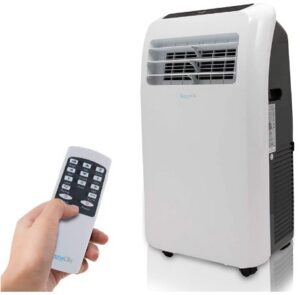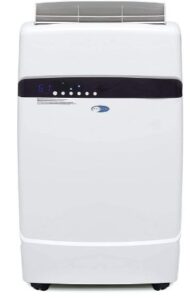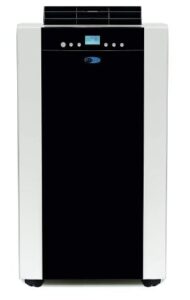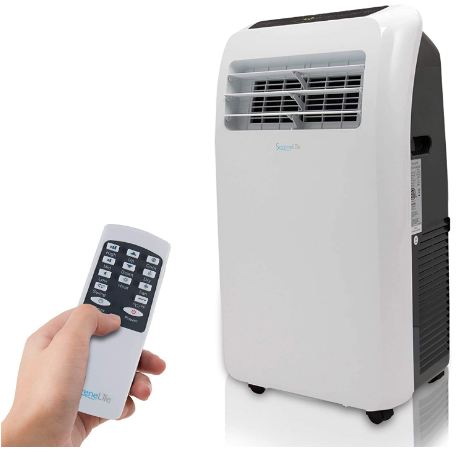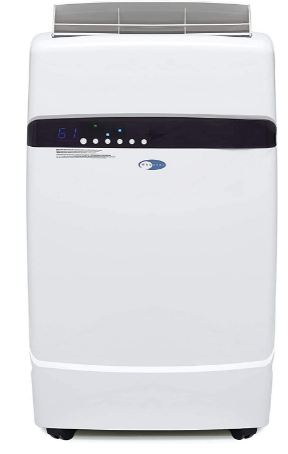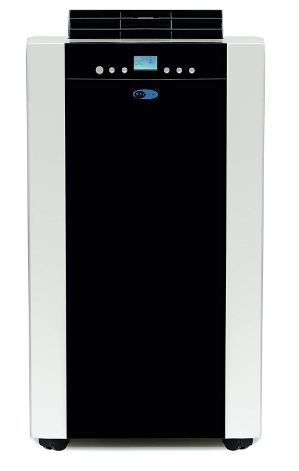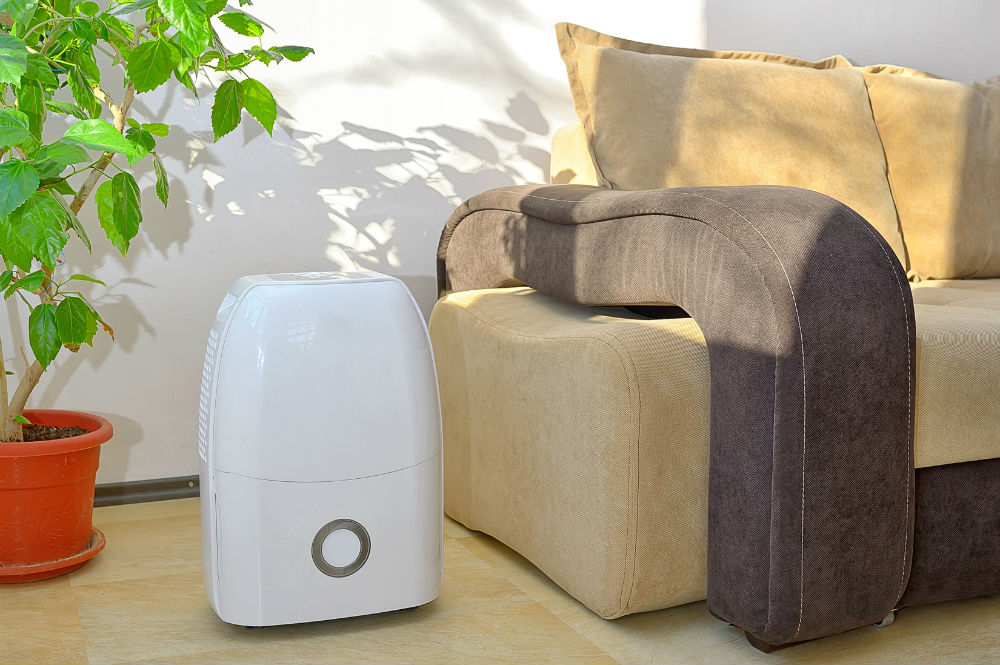Shopping for a portable air conditioner plus heater combo? Allow us to help you make a more informed decision.
When it comes to HVAC devices, cooling and heating combination units are the way to go. They are ideal for year-round usage, thanks to their dual functionality.
During summers, you can use them to keep your place cool. While in winters, they can keep your home warm and toasty.
However, not every portable AC and heater combination unit is built the same. Some are, of course, better than others in terms of both build and function.
So how do you decide which portable air conditioner and heater combo is the best for you and our needs?
We have rounded up the best models currently available on the market to help you choose a combo that will suit you best.
Who Should Buy a Portable Air Conditioner + Heater Combo?
Most air conditioner and heater combos are so portable and compact that they fit inside most households without requiring professional installation.
Here is a brief account of who can benefit from a portable air conditioner + heater combo:
People Who Live in Rented Spaces
People who rent houses cannot make any major structural changes to them. However, that does not mean they have to spend summers sweating and winters trembling.
A portable air conditioner and heater combo unit, with its lack of permanent installation, is perfect for keeping them comfortable all year round. Since there’s no need to make windows or drill holes in the walls, landlords are unlikely to object.
Students Living in College Dorms
College dorms are one of the smallest living spaces, and students living in them have to be particular about space consumption.
That’s why a portable air conditioner and heater combo is a great choice. It will keep them cozy and comfortable without occupying too much space.
Small Homeowners
People who live in small houses have to utilize the available space carefully. And two standalone heating and cooling devices take up a lot of space.
So a combination unit is definitely better for them.
Homeowners Without Central HVAC Systems
Because of the higher overall costs of central HVAC systems, not everyone is keen on getting one.
A portable air conditioner and heater like the Black & Decker Portable AC with Heat Pump is an excellent alternative because of the lower upfront cost, lack of installation, and affordable running costs.
Our Top 3 Picks
- 4 operation modes: AC, Heat, dehumidifier, fan-only
- Boasts multiple fans and cooling levels
- Includes remote control with all major functions
- Equipped with a dual-hose venting system
- Pulls outside air to cool itself down
- Self-evaporative function greatly reduces the amount of water you have to drain
- Dual-hose design greatly enhances its effectiveness
- Features four operation modes: AC, Heat pump, Dehumidifier and Fan-only
- An activated carbon filter helps eliminate odors
What's In This Buying Guide
Table of Contents
This buying guide explains everything you need to know about a portable air conditioner and heater combination unit.
It starts with who should purchase the combo and mentions our top picks for you to check out.
A comprehensive comparison table lists their features, and there’s a detailed review for each unit that covers its features, pros, and cons.
Further below is a shopping guide that describes the different aspects and features you should look out for. Towards the end of this guide is an FAQ section that addresses common concerns about a portable air conditioner and heater unit.
Best Portable Air Conditioner and Heater Combo
- Best for Small Spaces: SereneLife SLPAC
- Best For Medium Spaces: Whynter ARC-12SDH
- Best For Large Spaces: Whynter ARC-14SH
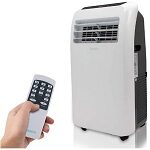
SereneLife SLPAC
Category
Best for small spacesDimensions
17.4 x 13.4 x 32.1 inchesWeight
56.48 PoundsArea Coverage
Up to 350 sq ftCooling BTUs
10,000 BTUsHeating BTUs
9,000 BTUsEER Rating
8.7Hose Configuration
Single HosePower Supply
1150 WattsRemote Control
YesNoise
52 – 56 dBWarranty
1 year
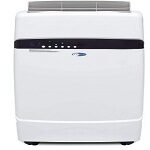
Whynter ARC-12SDH
Category
Best for Medium SpacesDimensions
16.5 x 20 x 34 inchesWeight
71 poundsArea Coverage
Up to 400 sq ftCooling BTUs
12,000 BTUsHeating BTUs
11,000 BTUsEER Rating
10.9Hose Configuration
Dual HosePower Supply
1100 WattsRemote Control
YesNoise
<56 dBWarranty
1-year on unit and 3-year on compressor
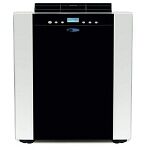
Whynter ARC-14SH
Category
Best for Large SpacesDimensions
16 x 19 x 35.5 inchesWeight
80 PoundsArea Coverage
Up to 500 sq ftCooling BTUs
14,000 BTUsHeating BTUs
13,000 BTUsEER Rating
10.8Hose Configuration
Dual HosePower Supply
1300 WattsRemote Control
YesNoise
<56 dBWarranty
1-year on the unit, 3-year on compressor
The SereneLife SLPAC is a compact and lightweight 4-in-1 portable AC and heater combination model and is best for making any small area comfortable. It is a versatile device with great portability and features.
PROS
- Compact size is ideal for rooms with small square footage
- Offers decent dehumidifying performance despite its small size
- Highly suitable for small rooms and areas
- Evaporative function eliminates the need for regular draining
- Simple to set up and use
CONS
- Has a single-hose configuration, which consumes more energy
- The hose is smaller than other comparative units
Features
- 4 operation modes: AC, Heat, dehumidifier, fan-only
- Boasts multiple fans and cooling levels
- Includes remote control with all major functions
- Moving vents improve air circulation
- Removes about 3 pints of moisture per hour
Our Review
The SereneLife SLPAC Portable Air Conditioner & Heater is an efficient yet powerful unit for heating and cooling purposes. It can effectively cool an area of 350 square feet. While on heat mode, it can warm any room measuring up to 300 square feet.
Another noteworthy feature is its remote control operation. It also has digital touch buttons that you can use to adjust the temperature, power it up, switch between different modes, and set the timer along with the fan speed.
The SLPAC is a 4-in-1 model with four modes of operation: heating, air conditioning, fan-only, and dehumidification. It can operate at variable speeds on the fan mode, so you can choose your preferred setting.
As a dehumidifier, it can effectively remove about three pints of moisture per hour. All these impressive features surely make it a solid option for you to consider.
The Whynter ARC-12SDH is one of the best portable air conditioner and heater combos out there. While there is no shortage of options, this unit stands out for its performance, portability, and price.
PROS
- Boasts an attractive and eye-catching design
- Operation is simple and hassle-free
- You can use it all-year-round for heating and cooling
- Does not claim a lot of floor space
- Has the same area coverage for both heating and cooling modes
CONS
- Makes significant noise
- Expensive
Features
- Equipped with a dual-hose venting system
- Pulls outside air to cool itself down
- Self-evaporative function greatly reduces the amount of water you have to drain
- Can extract 96 pints of moisture per day
- Has CFC-free GREEN R-410A refrigerant.
Our Review
The Whynter ARC-12SDH stands out to us not just because of its design, although it certainly is something to talk about. But it stands out to us because of its performance and energy efficiency.
It has one of the highest energy-efficiency ratings amongst portable HVAC models. Its 10.9 rating is quite higher than the average 8.5.
Moreover, it has a dual-hose configuration, which is also one reason behind its low energy consumption.
Unlike its single-hosed counterparts, it does not create negative pressure inside the room. Instead, it pulls in outside air with the first hose and uses it to keep itself cool.
It also relies on this air to carry away the heat generated via the second hose. Hence, it is highly effective for both heating and cooling.
We also liked the warranty coverage of the device. It comes with a one-year warranty on the AC itself, while a three-year warranty backs up the compressor. So, if it starts causing issues, you can ask Whynter to check it out for you.
The Whynter ARC-14SH is one of the company’s best-selling units and had Consumer Report’s 2020 highest score. It was also awarded Good Housekeeping’s 2020 Best Overall award for portable air conditioners.
PROS
- Feature-rich and environment-friendly
- Has a full thermostatic control
- Three fan speeds to choose from
- Delivers impressive performance both in cooling and heating
CONS
- Slightly heavier than other models on this list
- Comes with an expensive price tag
Features
- Dual-hose design greatly enhances its effectiveness
- Features four operation modes: AC, Heat pump, Dehumidifier and Fan-only
- An activated carbon filter helps eliminate odors
- Uses a CFC-free refrigerant for its operation
- Removes up to 9 gallons of moisture per day
Our Review
This cooling and heating combination unit is the most powerful machine on our list. Whynter has specially designed it to deliver impressive performance and efficiency both in cooling and heating.
The elegant and modern combination machine is your one-stop solution for temperature regulation. And it does so without looking misfit in any décor.
It has an impressive cooling capacity of 14,000 BTUs and generates 13,000 BTUs for heating. With the higher BTU measurement, it can easily cover spaces as large as 500 square feet.
But that does not mean you cannot use it in smaller rooms. It also features three fan speeds, so you can adjust it according to the size of the space you want to heat or cool.
The ARC-14SH is not just meant for temperature regulation. It also works effectively as a dehumidifier.
When you switch to the dry mode, it simply extracts excess moisture from the humid air.
With most other models, you have to worry about removing the water that accumulates inside the reservoir, but this is not a problem with this Whynter unit.
Its evaporative function allows it to remove most of the condensate water automatically, leaving behind only a tiny amount for you to deal with.
Portable AC and Heater Combo Buying Guide
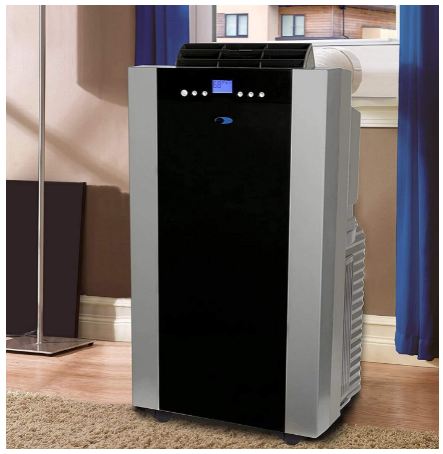
How does the Portable AC and Heater Combo Work?
Portable AC and heater combos work on the principle of the refrigeration cycle. In this process, a chemical (refrigerant) takes thermal energy (heat) from one part of the system, transports it to the other part, and then releases it.
It all happens with the help of four components – compressor, condenser, expansion valve, and evaporator. To help you understand their functionality better, here’s the role each part plays in the refrigeration cycle.
Compressor
As the name suggests, the compressor compresses the refrigerant and converts it into hot pressurized gas. Now, this hot gas is forced into the condenser.
Condenser
The condenser, also known as the cooling coil, is a long coiled tube. When the hot refrigerant passes through the coil, it dissipates heat to the surrounding air, gradually cooling down.
A fan is usually present to speed up the process. It completely cools the refrigerant and converts some of it into a liquid state. Now, the gas is cold and high in pressure and is pumped into the expansion valve.
Expansion Valve
The expansion valve allows the refrigerant to expand. As its molecules move away from each other, their overall pressure reduces. In this component, the refrigerant completely returns to its liquid form before being pumped into the evaporator.
Evaporator
The evaporator is also a long, coiled tube. Here, under low-pressure conditions, the liquid refrigerant starts converting into a gaseous state again. To facilitate the evaporation process, it starts pulling heat from the surrounding air. As it absorbs heat, cold air is blown outside by the fan to cool the room.
A portable AC and heater combo unit uses the same components for both cooling and heating purposes. When cooling, it pumps the heat dissipated by the condenser outside and blows cold air from the evaporator into the room.
But when you use it as a heater, the unit reverses the cycle. It is equipped with a reversing valve which changes the direction in which the refrigerant flows.
The condenser coils and evaporator coils switch roles, with the condenser becoming the evaporator and vice versa. Now the system dissipates cold air and starts blowing hot air from the vents.
Types of Portable AC and Heater Combo
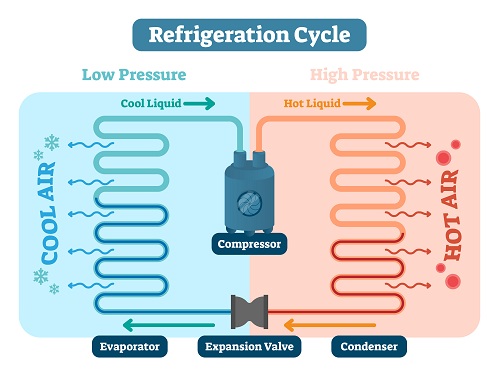
Portable AC and heater combo units are similar in functionality and offer four modes of operation. However, they are classified according to their hose configurations.
Single or One Hose
Units with a single exhaust hose on their back for venting are classified as one hose units. They pull in air from inside the room and cool a part of it to blowback inside, venting out the rest along with the collected heat and moisture.
This creates a negative air pressure inside the room, causing warm air to enter via doorways, holes, and structural cracks to fill in for the “missing” air.
Hence, the unit has to work harder to maintain a comfortable temperature inside the room.
Dual or Two Hose
Dual-hose portable AC and heater models use two hoses to avoid the negative air pressure problem. The system draws air from the room, cools it down, and blows it back.
The heat absorbed during his process makes the system hot, so one hose brings in air from the outside. The system uses it to cool down and expel the absorbed heat and moisture outside via the second hose.
Overall, dual-hose units are more efficient and effectively cool an area without overworking, heating up, or increasing your energy bills.
Why buy Portable AC and Heater Combo Over Other Kinds?
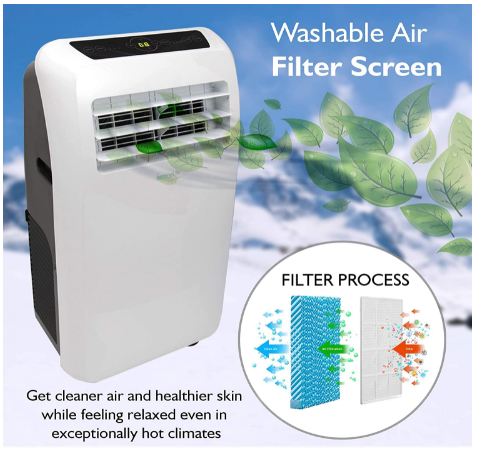
There is a vast range of combination heating and cooling devices available on the market, so why choose the portable variation? The comparisons below can help answer this question.
Portable AC and Heater combo Vs. Central HVAC Systems
If you want to heat or cool your entire house, a central HVAC system is undoubtedly the better choice.
However, these systems regulate a similar temperature throughout the house. You cannot get it to heat or cool a specific room at a higher or lower temperature. Also, these systems have a higher upfront cost, require professional installation, and are costlier to run.
On the other hand, a portable AC and heater combo is ideal for targeted temperature regulation. You can use it to keep specific rooms hot or cold.
And since it is portable, you can use it in any part of the house.
Portable ACs are more affordable to buy and run and don’t require professional installation to set them up.
Portable AC and Heater Combo Vs. Window Units
While window AC units are undoubtedly more effective than their portable counterparts, most either lack a heating function or are very expensive to purchase and run. They require a dedicated window for their installation, and if they are not installed correctly, they run the risk of falling out.
Portable heating and cooling combination units may be more expensive than window units, but they are certainly less costly to run. They come pre-assembled and don’t block any windows to obstruct the natural light and view.
You can move these portable units from room to room or even to a different home when you decide to move. Additionally, most building associations don’t mind them as much as they mind window units.
What to look for When Buying a Portable AC and Heater Combo
While hundreds of portable AC and heater combination units are available in the market, not every unit is the same. To separate high-quality units from unreliable ones, you should know what to look for. Some important factors include:
BTU
The BTU rating of a portable AC and heater combo device denotes its cooling and heating capacity. The higher the BTU rating, the more the area a device will cover.
Hence, it is crucial to know the size of the area you want to regulate.
Earlier, the EPA asserted that for every square foot of area, 20 BTUs are required.
But later, because of the difference in the performance of portable and fixed units, a new BTU measurement, SACC (Seasonally Adjusted Cooling Capacity), was introduced.
Now, the correct sizing for portable temperature regulation units is 39 BTUs per square foot.
Note that in combination units, there is a separate BTU rating for both heating and cooling. So be sure to choose the right size for effective temperature regulation.
Fan Speed
Variable fan speed is a sign of a good-quality unit. This feature not only allows you to control the speed of air blowing out of the unit but also plays a vital role in the energy conservation and noise of the device.
The higher the fan speed, the more the noise and power the device will consume.
A device with a fixed fan speed won’t allow you to adjust it according to your personal preferences, so a device with a variable fan speed is the better choice.
Remote Controls
Once you feel relaxed and become comfortable, getting up to adjust the temperature on the unit feels like a tough task. That’s why many portable AC and heater combo units come with the convenience of remote control operation.
Some even connect with your smartphone over Wi-Fi and allow you to control them with it. But they entail a higher upfront cost.
The best you can do is look for a model that supports some form of remote control operation but does not exceed your budget.
Noise Levels
One shortcoming of portable AC and heater combo units is their noise. While they are the noisiest kind of HVAC systems, you can find units that boast quiet and noiseless operation.
It is said that sound levels above 70 dB over a prolonged period may start to damage your hearing. The quietest portable unit emits about 45 dB of noise which is lower than that of a normal conversation at 60 dB.
If you are sensitive to noise, it’s better to choose a unit with a lower rating.
Energy Efficiency
One fear that limits our use of heating or cooling devices is the high electricity bills. But if the portable AC and heater combo model you choose is energy-efficient, it will not put any extra burden on your budget.
You can learn about the energy efficiency of different units by checking their Energy Star certification. Energy Star certified units are better at conserving energy and save you a lot of money in the long run.
Portability
Despite being advertised as portable AC and heater combination units, not all of them are equally portable. Certain features make a device more portable than others, such as lower weight and ergonomically placed handles and wheels.
When shopping for a suitable unit, make sure it is easy to wheel around because moving a heavy machine, especially on a carpet, is one of the most challenging things to do.
Warranty
The warranty coverage of a portable AC and heater combination is an important consideration.
Warranty is proof that the device is high both in quality and performance. Only manufacturers who are completely confident about their products offer good warranty coverage to show it.
So, look for units that come with a comprehensive warranty.
Pros and Cons
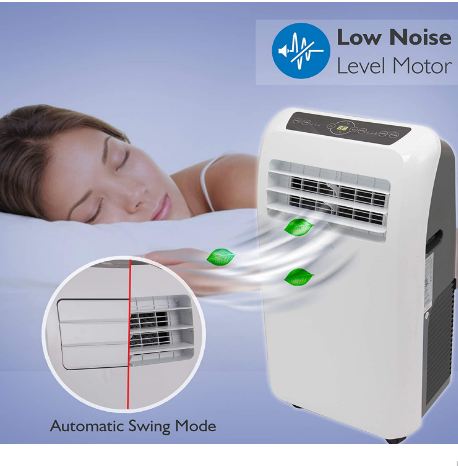
A portable AC and heater combination unit is a great solution for year-round temperature regulation. However, it has its drawbacks, too.
Pros
Versatility
The most significant advantage of using a portable AC and heater combo is its versatility. The device can alternate between heating and cooling modes, creating the perfect indoor environment to keep you comfortable.
On hot days, it produces cold air, and during winters, it keeps you warm and toasty with its heated air.
Portability
Like the name already suggests, these machines are extremely portable. Their use is not restricted to a single room; instead, you can use them all around the house.
For this purpose, they are usually equipped with ergonomic handles and wheels for easier movement. Manufacturers also try to keep them as light as possible, making them much easier and much more convenient to pull and push around.
Affordability
Compared to traditional central heating and cooling devices, portable AC and heater combination units are generally more affordable.
Apart from the upfront costs, they don’t require any installation, so there are no installation costs too. Their operation cost also lies towards the lower end of the price spectrum, so you can continue to use them without being very careful.
Save space
Setting up two separate devices for heating and cooling usually consumes a lot of space. But with a portable combination unit, you can save a lot of space.
They are compact, so they do not occupy much floor space. You can easily use them even if you live in a small apartment as they can easily fit in small spaces.
Easy to set up and operate
Another great advantage of investing in portable AC and heater combination units is their ease of setup and operation. These devices usually come pre-assembled, so they are essentially plug-n-play.
There is no need to hire professional services for their installation. Also, they are simple enough to use. Just reading the enclosed instruction manual is usually enough.
Cons
Noise
Some models boast super quiet operation, but most portable combination units available on the market are noisy. Their noise levels vary from 50 dB to over 70 dB. While the noise itself is definitely irritating, prolonged exposure to higher noise can actually damage your hearing as well.
Frequently Asked Questions
Is it necessary to vent a portable AC in Heat Mode?
Regardless of the mode, you run your portable AC on, and it needs venting to function optimally. If you don’t set up the window kit to vent it in heat mode, the unit will exhaust the cold air back inside the room, and there won’t be any noticeable change in the room temperature.
So yes, it is necessary to vent a portable AC in heat mode too.
Is it possible to maintain perfect room temperature with an AC/Heater combo?
Yes, it is possible to maintain perfect room temperature with a portable AC/heater combo.
When the room is hot, you can get the unit to cool it down. And when the room is cold, you can set it up to make it warm and toasty. So, a portable AC/heater combo device will effectively maintain the perfect room temperature regardless of the weather and external temperature.
How much energy does a portable AC/heater combo unit use?
Although Energy Star-rated models use less energy, a portable AC/heater combo unit uses as much energy as a regular portable AC or a space heater.
To generate 10,000 to 14,000 BTUs of cooling, a combo unit requires about 1100W to 1800W of power input. And for 9,000 BTUs to 1,300 BTUs of heating power, it may consume anywhere from 1000W to 1700W of electrical input.
How do I calculate the BTUs?
Basically, BTUs denote the temperature regulation capacity of the device. It is directly related to the size of the room that you want to cool.
For portable AC and heater combination models, it is recommended that you have at least 30 BTUs for each square foot of area you want to cool. Hence, for an area of 200 sq ft, you need about 6,000 BTUs. Similarly, for cooling an area of 300 square feet, you will need 9,000 BTUs, for 400 square feet, 12,000 BTUs and so on.
Final Verdict: What is the best Portable AC and Heater Combo?
After carefully examining the different options available on the market, we find the Whynter ARC-14SH the best portable AC and heater combo unit. It is a powerful unit with highly efficient cooling and heating performance.
But if you want something less powerful for your medium-sized room, go for Whynter ARC-12SDH.
The SereneLife SLPAC Portable Air Conditioner & Heater, on the other hand, is an excellent choice for smaller spaces.
I’m a degreed ME (mechanical engineer) who is passionate about machines of all kinds. I created MachineWonders.com as a way to connect with others who love machines like me – or need help choosing one for their needs, application, or situation.


